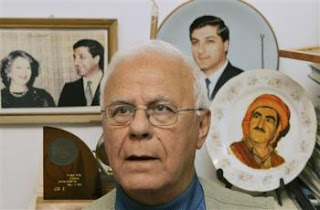RAMAT HASHARON, Israel (AP) — In 1983, Mossad agent Eliezer Tsafrir observed Imad Mughniyeh's handiwork from a rooftop in Beirut: two rising mushrooms of smoke and wailing ambulances racing to collapsed buildings where nearly 300 American and French troops had just been killed.

| | ||
| Eliezer Tsafrir, an ex-Mossad agent who was the Israeli intelligence organization's Beirut station chief in 1983 and 1984, is seen at his home in Ramat Hasharon, Israel, Monday, Feb. 18, 2008. In an Associated Press interview, Tsafrir offered an insider's take on Imad Mughniyeh's mysterious assassination last week, saying it would have required years of patient intelligence work by dozens of operatives. (AP Photo/Ariel Schalit) | ||
Tsafrir, then Beirut station chief for the Israeli spy agency, was in a unique position to see the rise of the Lebanese terror mastermind. In an Associated Press interview, Tsafrir offered an insider's view of Mughniyeh's mysterious assassination last week, saying it would have required years of patient intelligence work by dozens of operatives.
Mughniyeh's organization, Hezbollah, and its Iranian backers immediately blamed Israel for the explosion that ripped through his Pajero SUV in the Syrian capital on Feb. 12. Israel issued an official denial of involvement, though some military officials' subsequent denials were less emphatic.
Now a 74-year-old grandfather in sneakers and a sweat shirt, Tsafrir retired in 1992 after an intelligence career that included stints heading Mossad operations in Tehran and Kurdish regions in Iraq. At his small apartment in a leafy Tel Aviv suburb, decorated with photos and other mementos from his years of service, Tsafrir looked back on Mughniyeh's career and his violent demise.
The attacks Tsafrir witnessed in October 1983 were among the first attributed to Mughniyeh — a pair of simultaneous suicide truck bomb explosions that killed 241 American soldiers and 58 French paratroopers. Over the next quarter century, Mughniyeh would be linked to a long list of others, including airplane hijackings, kidnappings, bombings at Israel's embassy and a Jewish community center in Argentina, and other attacks in Europe and the Arab world. He had been in hiding for years and reportedly had undergone plastic surgery to avoid being found.
The Mossad's agents in Beirut became aware of the young Mughniyeh in the early 1980s, after Israel invaded Lebanon to evict Palestinian militants who had taken over swaths of the country, Tsafrir said. Tsafrir was dispatched to run the Mossad's Beirut operation in 1983, leaving the following year.
Mughniyeh, a Shiite Muslim from southern Lebanon, first signed up to fight with Yasser Arafat's Palestinian forces and then became one of the founders of a small pro-Iranian faction of local Shiites.
"We started hearing his name at that time," Tsafrir said.
That group eventually morphed into the formidable Hezbollah organization, and Mughniyeh became the group's operations officer and one of the world's most wanted terrorists.
Mughniyeh's attacks touched Tsafrir personally: His brother and his son both narrowly escaped separate suicide attacks while serving in Lebanon. The Israelis believed both attacks were planned by Mughniyeh.
Israeli agents in Lebanon were shocked by Mughniyeh's tactics, Tsafrir remembered. Suicide bombing, unknown at the time, would be picked up by Palestinian militants in the 1990s, then elsewhere in the Islamic world before reaching a horrifying climax with al-Qaida's Sept. 11, 2001, attacks in the U.S.
"We asked ourselves, 'How can this be?'" Tsafrir said.
Although Israel and the U.S. perhaps top the list of suspects in Mughniyeh's assassination, Tsafrir said, France, Germany, and Saudi Arabia are also among countries that had "unsettled accounts" with him. And he likely had internal opponents.
"A person like this makes a lot of enemies," Tsafrir said.
An operation like the one that killed Mughniyeh last week would have been extremely complex, requiring years of intelligence work and dozens of people, he said. "It's not a matter of just pressing the button," he said.
"An operation like this would take tremendous amounts of intelligence — human intelligence, not electronic intelligence," he said. "You need the ability to find people, to check the location, to install the device, and to escape" — no simple task in the middle of a hostile capital.
"The agents could be recruited, or infiltrated into the organization, or both. But there would be dozens involved, and everything would be compartmentalized: People wouldn't know what the others were doing, and would only know what they needed to know," Tsafrir said.
Mughniyeh's assassination has generated swirls of speculation. Some anti-Syrian politicians in Lebanon have accused Damascus of being behind the killing. U.S. Director of National Intelligence Mike McConnell has suggested factions within Hezbollah or the Syria regime may be to blame. Reports in the Arab press have suggested Palestinians might have been involved.
Hezbollah declined to comment on the U.S. claim. The Syrians have said they are investigating and will make an announcement when the inquiry ends.
Asked what the Mossad's policy is toward targets like Mughniyeh, Tsafrir would only give an example from the past: In 1972, after Palestinians from the Black September group killed 11 Israeli athletes at the Munich Olympics, Israeli Prime Minister Golda Meir gave an order to kill those who were responsible or were planning new attacks.
Over the next 10 years, Palestinian operatives were killed in cities across Europe in attacks widely attributed to Israeli agents.
| Eliezer Tsafrir, an ex-Mossad agent who was the Israeli intelligence organization's Beirut station chief in 1983 and 1984, speaks on the phone at his home in Ramat Hasharon, Israel, Monday, Feb. 18, 2008. In an Associated Press interview, Tsafrir offered an insider's take on Imad Mughniyeh's mysterious assassination last week, saying it would have required years of patient intelligence work by dozens of operatives. (AP Photo/Ariel Schalit) |


No comments:
Post a Comment